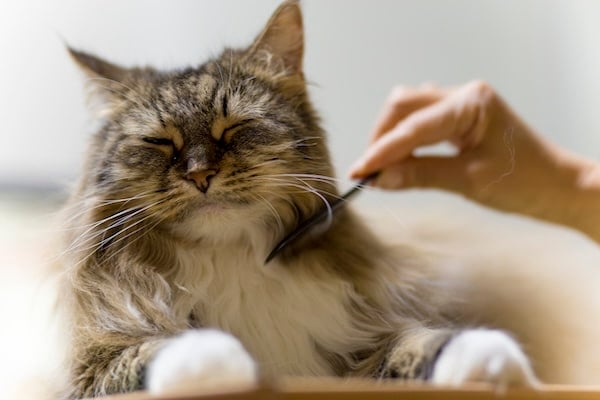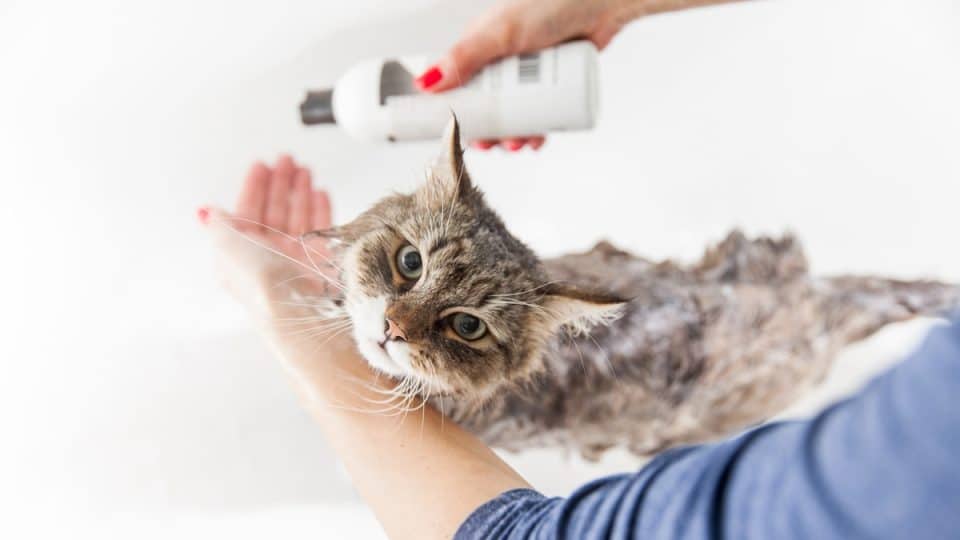- This post contains affiliate links. Read more here.
- Not a substitute for professional veterinary help.
Every once in a while, your cat will get into a messy situation that may require a bit of spot cleaning. Very rarely do cats require a full body bath, according to Ingrid Johnson, a Certified Cat Behavior Consultant and Fear Free Certified Groomer at Fundamentally Feline, because they are self-cleaning.
Cats also hate water, so frequent baths can ruin your cat’s trust in you, especially for new cat parents. It’s important, says Johnson, to ask if you’re bathing your cat because your cat needs it or if you want it.
This guide will clarify when a cat bath is truly necessary and how to make the process as stress-free as possible. We’ll walk you through the right supplies and a step-by-step process to keep both you and your cat calm.
Do Cats Need Regular Baths?
Veterinary experts, including Johnson, agree that most cats do not need to be bathed by their pet parents. When a cat licks themselves, their rough tongues remove dirt and oils and keep their coats in top condition. As a cat parent, often weekly brushing will help keep your cat clean and matt-free.
When Cats Need a Bath
If your cat isn’t dirty or dealing with a health issue, bathing your cat can cause unnecessary stress for them. However, medical conditions and illnesses that require bathing assistance for your cat include:
- Hindlimb paresis
- Bladder disorders and diseases
- Obesity
- Incontinence
- Fungal infections or skin conditions
- Skin allergies resulting in lesions or ulcerations
- Chronic diarrhea or IBS
Cats with arthritis struggle to clean themselves because the stiffness in their joints makes it difficult for them to reach certain areas of their body, says Johnson. They also often have metabolic disease, driving thirst and resulting in dehydration, so they don’t have enough saliva to lick themselves.
Cats with incontinence or IBS may need frequent baths because they can’t fully clean themselves, leading to urine and feces accumulating on their fur and skin, which can cause irritation, sores, and potential infections.
Step-by-Step Instructions
There are products and methods to help tackle sticky or dirty spots, if your cat’s self-grooming habits aren’t getting everything. When your cat needs a little extra help getting clean, make the experience as calm as possible with our step-by-step instructions.
- Comb the coat. Before giving a cat a bath, comb through their fur to remove any loose hair or tangles. “If you are going to bathe a cat, it’s imperative they’re combed out or shaved first,” says Johnson. “It’s best not to get them wet with a thick, unkempt, or partially matted coat, because you’ll end up with one solid knot.”
- Place a bath mat or towel in the tub or sink.
A bath mat will help your cat feel more secure and prevent slipping. - Gently place your cat in the tub or sink.
Carefully set your cat in the tub or sink, allowing them to hold onto the side of the tub with their front paws while standing on their back feet. “It’s a good position because you can spray all of their body except for their face, resulting in a quick lather and rinse. It also gives you access to the whole body, which gets the process over as quickly as possible,” adds Johnson. - Wet the coat with a shower head or small sprayer.
Johnson recommends using a shower head because they tend to have more moxie. With a shower head, cats may feel less overwhelmed and trapped compared to being submerged in a large amount of water in a sink or tub. The shower head also allows for more precise control over where the water is directed, avoiding sensitive areas like the face and ears. - Apply cat shampoo.
Rub a small amount of cat-safe shampoo (or medicated shampoo if you’re bathing your cat for a specific condition) onto the areas you’re washing. Be gentle and work in the direction of the fur to avoid tangling. - Rinse out the soapy areas.
Rinse the shampooed areas thoroughly with clean, warm water. Make sure all soap residue is gone to prevent skin irritation. - Wring out excess water.
Gently squeeze or wring out the extra water from your cat’s coat with your hands. This will help speed up the drying process. - Towel dry.
Wrap your cat in a large, soft towel and gently pat them dry, soaking up as much moisture as possible. - Blow dry and brush.
“Their coats hold water, so they don’t dry very quickly,” says Johnson. She recommends using a blow dryer on low heat to finish drying your cat’s coat, and brush their coat as you go to prevent tangles.

CasarsaGuru via iStock
Where to bathe a cat
When giving a cat a bath, choose a space that’s comfortable for both you and your cat, like a tub (or a kitchen sink in a pinch). A handheld shower sprayer is ideal to get the job done quickly, says Johnson, but be sure the water pressure is strong enough for an efficient rinse. A weak spray can make the process drag on, so aim for a steady, firm stream of water to quickly remove all the soap and minimize your cat’s discomfort.
If you don’t have a handheld showerhead, consider taking your cat to a professional groomer to ensure they are cleaned thoroughly and safely.
What shampoo to use
If you’re bathing your cat because they got messy or need a little assistance, make sure to use a cat-safe, unscented shampoo for a gentle clean.
For medicated baths to treat skin issues or fungal infections, the best method is to reach out to your vet for a shampoo recommendation.
Johnson also recommends following up with a conditioner or a leave-in conditioner, which will help keep your cat’s coat smooth and tangle-free.
Long-haired versus short-haired cats
According to Johnson, long-haired cats like Persians and senior cats might need a little extra care after a bath. It’s important to blow-dry them thoroughly and comb or brush their fur to prevent knots and mats, she says.
Because of their lack of fur, Sphynx cats often require regular baths. “They can get greasy, accumulate debris between their toes, and even develop acne,” adds Johnson.
Kittens
Only bathe kittens once they’ve reached two months old—before that, they can’t regulate their temperature well enough for a full bath. Once they’re old enough, use warm water and kitten-safe shampoo, keeping the bath brief and avoiding the face.
Tips and Tricks
Bathing a water-averse cat can be a challenge, but with a little preparation, you can make the experience easier for both of you. Here are some tips to help keep your cat calm and comfortable during bath time.
- Gently massage the neck. While washing, gently massage the back of your cat’s neck to help them relax (never grab, scruff, or shake).
- Keep the door closed. Keeping the door closed will prevent your cat from escaping mid-bath.
- Offer treats. Use treats to reward your cat, especially during combing or shaving. This can help turn grooming into a positive experience over time.
- Use waterless shampoo for tough spots. If your cat resists a full bath, a waterless cat shampoo is great for hard-to-reach areas like their rear, making cleanup quicker and easier.
- Try pheromone diffusers. Consider using cat pheromone diffusers to reduce your cat’s anxiety and create a calming atmosphere.
When to work with your vet or a professional groomer
“No matter how gently you give your cat a bath, it can still be a nightmare,” says Johnson. “In some cases, it’s best to get some pharmaceutical help.”
If your cat finds bathing extremely stressful or has had a traumatic bath experience, Johnson recommends consulting your vet. They might suggest a fear-free medication to make the process safer and more manageable for both you and your cat. You could also consider hiring a professional, Fear-Free-certified groomer to help.

S_Kazeo via iStock
How to Maintain Your Cat’s Cleanliness
So, how can you keep your cat well-groomed in a stress-free way? Below are some effective, gentle spot-cleaning methods:
- Unscented cat wipes: Cats are very sensitive to smells so stick to unscented cat wipes. Unscented baby wipes will also work in a pinch.
- Regular brushing with a dematting or deshedding Comb: Johnson recommends using a dematting or deshedding comb (like the Safari comb) with wide, alternating teeth, which can gently lift out mats and loose fur. Regular brushing will prevent tangles and help keep your cat’s coat healthy.
- Eye wipes: Gentle eye wipes are especially helpful for breeds like Persians or Himalayans to clear tear stains and prevent buildup around the eyes.
- Cotton balls for ears: To keep your cat’s ears clean, use a soft cotton ball to remove wax and dirt, but be careful not to go too deep.
For cat parents who don’t need to frequently groom their cats, following these tips on a weekly or monthly basis (depending on your cat’s coat type) can help you stay assured your cat is clean.



